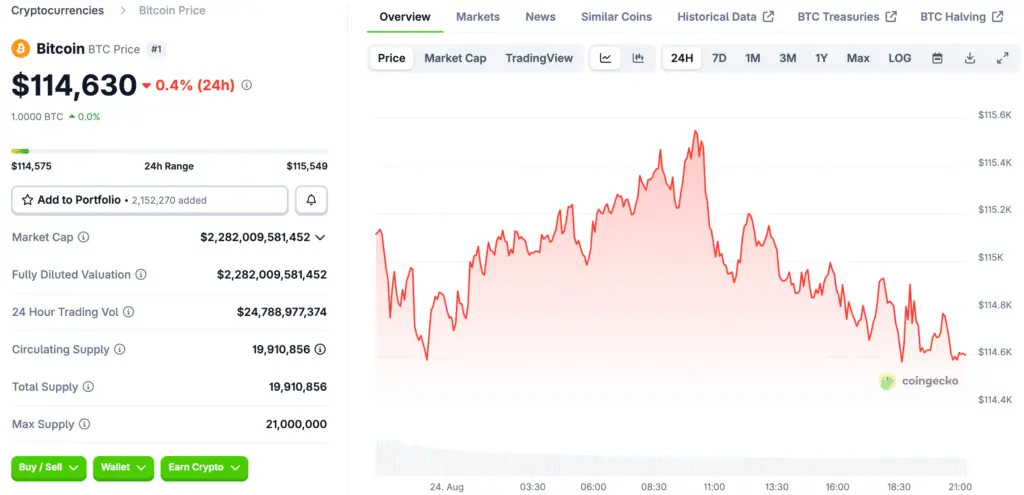How BlackRock’s Outflows Affect Bitcoin
The cryptocurrency market is currently witnessing a significant and sustained institutional exodus, with major players like BlackRock leading the charge. This trend has created notable selling pressure on Bitcoin, contributing to its recent price consolidation. BlackRock’s iShares Bitcoin Trust, or IBIT, recorded a substantial outflow of nearly $200 million in a single day, an event that reverberated throughout the market. This large-scale selling from a prominent institutional player is a powerful signal of bearish sentiment, at least in the short term.
It has contributed to a liquidity crunch during US trading hours, which in turn has caused Bitcoin’s price to soften and fluctuate within a tighter range. This type of institutional action can be a bellwether for the broader market, as these firms often have a significant impact on sentiment and trading volumes. The cumulative effect of these outflows has been a withdrawal of over a billion dollars from Bitcoin ETFs in a short period, marking a clear shift from the previously dominant narrative of continuous institutional accumulation.
The Broader Institutional Exodus Explained
Bitcoin ETF outflows have reached $1.2 billion since August 15, indicating a broader retreat by institutional investors due to recent market volatility. This trend is exemplified by a $500 million transfer of Bitcoin to the Coinbase exchange, often associated with firms offloading large quantities of the asset.
This coordinated bearish sentiment comes after Bitcoin reached an all-time high of $124,000, suggesting investors may be taking profits or adjusting their risk exposure. The maturity of the Bitcoin market, where institutional capital flows can significantly influence price action and market liquidity, is highlighted by the concentration of power and influence in the hands of a few major institutions.

Signs of a Potential Trend Reversal
Despite widespread outflows, there are signs of a trend reversal. Major investment firms like Ark Invest and Fidelity have recorded inflows, with a single day seeing over $65 million in net inflows. This suggests a divergence in strategy among institutional investors, with some viewing price consolidation as a buying opportunity. The broader market environment is showing signs of improvement, with recent Federal Reserve statements suggesting a potential rate cut.
A more accommodative monetary policy could lead to increased liquidity and capital rotation back into risk assets like Bitcoin. This macroeconomic backdrop and continued buying from certain institutional quarters could set the stage for a reversal of the outflow trend and a renewed period of growth for Bitcoin.
Bitcoin’s Price Consolidation and Volatility
The institutional tug-of-war has resulted in Bitcoin’s price consolidating within a critical range of $111,000 to $117,000. This period of consolidation is not merely a pause in the market but a crucial phase that will likely determine the asset’s next major price movement. The volatility during this time is a direct consequence of the large-scale inflows and outflows, which create sharp price swings as liquidity tightens and loosens.
The consolidation range represents a key support and resistance zone that traders and analysts are closely monitoring. A decisive break above or below this range could signal the start of a new trend. The presence of significant institutional outflows has added a layer of uncertainty and volatility to this consolidation period, making it a tense time for both retail and institutional investors.
The Philippines Strategic Bitcoin Reserve
In a development that stands in stark contrast to the institutional selling in the West, the Philippines has proposed a groundbreaking initiative to establish a strategic Bitcoin reserve. A bill introduced by a congressman would require the country’s central bank to acquire 10,000 Bitcoin over a period of five years, valued at approximately $1.1 billion at current prices. This strategic reserve would be held for at least two decades and could only be used for retiring government debt.
This proposal is a monumental step for a nation-state, as it positions Bitcoin as a legitimate long-term asset akin to gold, rather than a speculative investment. This move signals a growing recognition of Bitcoin’s potential as a hedge against currency devaluation and a tool for national financial diversification.
How National Policy Influences Crypto Markets
The Philippines’ proposed Bitcoin reserve is a powerful example of how national policy can fundamentally influence the cryptocurrency market. If enacted, this initiative could set a precedent for other developing and developed nations seeking to diversify their financial holdings. It would lend a new layer of legitimacy and credibility to Bitcoin on a global scale, attracting the attention of other governments and financial institutions.
This top-down adoption, driven by central banks and national legislatures, could be a significant catalyst for a new phase of institutional and sovereign investment in digital assets. While Western institutions are grappling with short-term market dynamics, nations like the Philippines are looking at Bitcoin through a long-term, strategic lens, viewing it as a tool for national financial security and stability.
What the Future Holds for Bitcoin and Institutions
The current market environment presents a fascinating dichotomy. On one hand, you have Western institutional players taking profits and contributing to short-term bearishness. On the other hand, you have a nation-state like the Philippines making a long-term strategic bet on Bitcoin’s future. This contrast suggests that the narrative around Bitcoin is evolving. It is no longer just a speculative asset or a retail investment but a strategic reserve asset for nations and a core component of institutional portfolios.
The next several months will likely be defined by the interplay between these two forces. A continued institutional sell-off could prolong the consolidation phase, while positive developments like the Philippines’ initiative could provide a strong fundamental foundation for a future bull run. For investors, the key will be to look beyond the daily price fluctuations and consider the long-term, structural shifts that are currently underway.
Read More: Philippines Proposes Bill to Buy 10,000 Bitcoin for National Reserves















